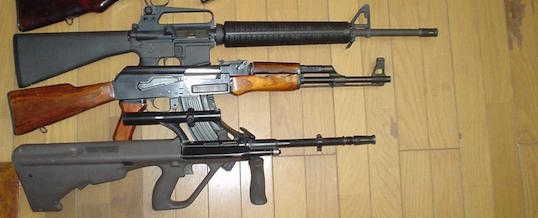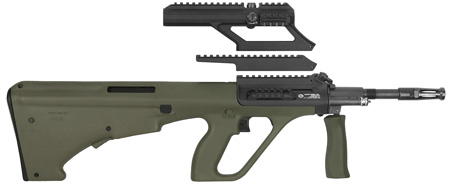
The Bullpup Rifle Experiment, Part 2: what did I learn about bullpup rifles?
If you’ve read Part 1 of The Bullpup Rifle Experiment, you’ll know that I started out this little project with a relatively simple goal: to find out what the bullpup rifle was all about. I wanted to learn what they were good for, what they weren’t, and perhaps even a little bit of why they seem to inflame passions on both sides: those who love them and those who love to hate them. Along the way I hoped to perhaps develop some training doctrine for these futuristic designs and dispel some of the training myths that have grown up around them.
(If you haven’t read Part 1, what are you waiting for? Click here to read it now!)
I started out simply playing with the Steyr AUG A3 M1 that Steyr Arms had sent me. “Playing” suggests haphazard recreation, but it wasn’t; I was doing dry reps to ingrain the gun’s functions and to get used to the very different control layout. The AUG was definitely a different beast from anything I’d used previously and so I was coming to the gun completely green. After a few days of dry practice I finally got to the range to really test it out, and the project was in full swing.
During this period, anytime I needed a rifle for something I picked up the Steyr instead of one of the guns I might normally grab. It replaced my AR-15 and my lever actions; if I took a rifle, the AUG went — exclusively. Other than sighting in a bolt-action .22, I didn’t shoot any other rifle, not even for a few rounds, once this odyssey began. I figured that if I were to learn the bullpup I needed to immerse myself in the world of the bullpup!
So what did I learn? Well, a complete discussion could take quite some time but I’ll share with you some of the more important things I discovered.
I learned that they’re short. Yeah, I know that seems obvious but I really think it needs to be mentioned. I’ve had people tell me that they didn’t really see a use for the bullpup rifle “because they’re just shorter, that’s all.” Well, that’s certainly not all there is to them; but for the moment let’s focus on that.
“They’re just shorter” is meant as a dismissal, but short rifles aren’t just cool — they’re useful, too. Getting the rifle out of storage, whether that’s a safe or a rack or the trunk of your car, is easier with the shorter rifle. Moving around obstacles, as you might have to do if you’re running from your storage spot to where the attack is happening, is a lot easier. Just going through doorways with the shorter rifle is easier than with a longer gun.
Remember the first time you picked up an M1 Carbine and marveled how small it was, how quickly it came onto target and how easy it was to carry around? A lot of that same feeling came to me the first time I started to handle the AUG. Now it’s not as lightweight as the old Carbine — it is, after all, a service rifle — but the short length made it feel oh-so-handy whenever I picked it up. After a while my 16” AR carbine seemed like one of those old bolt-action Mauser long rifles! I discovered that there is great virtue in small size (as did those armies who started chopping down their long bolt-action rifles to make carbines out of them.)
Let’s look at it this way: if shorter rifles aren’t handy, if they aren’t useful and desirable, why doesn’t everyone have a full-length AR-15 instead of the far more popular 16” versions? Why are so many people going through the cost and hassle of making registered short-barrel rifles (SBRs) or making AR pistols and attaching quasi-legal “shooting braces” to them?
It’s because once you handle a short rifle you appreciate its maneuvering qualities and how much better it fits into the typical suburban (or even rural) lifestyle than a longer gun.
Compared to the SBR, with the bullpup you don’t have to put up with the reduced ergonomics (because of the shortened buttstock) or the reduced ballistics (because of the shortened barrel.) You get a gun that instead handles and shoots more like a full-sized rifle, but in a handier and easier-to-use form factor.
I also learned that weight distribution is something we don’t often think about, but once you’ve experienced a rifle whose center of balance is on the pistol grip it changes your outlook. Reloading the rifle from the shoulder becomes easier; shooting one-handed “injured man” drills is a piece of cake; and swinging the gun onto target requires less effort. Even a lightweight 16” AR-15 is noticeably front-heavy in comparison, and the shorter the buttstock is the worse it gets. (Again, a curse of the AR pistol and SBR!) The neutral balance of the bullpup also makes it easier to carry in a “ready” position, whether moving around obstacles or just waiting patiently in the hot sun for your instructor to give the fire command!
Does the bullpup have weaknesses? Of course; all rifles do, it’s just that we’ve gotten used to some of them and now call them “features”!
The length-of-pull on a bullpup is almost universally longer than even an AR with an A2 buttstock, and it can’t be changed. This can cause issues for someone with very short arms. (That describes me, actually, and the bullpups I’ve shot are about as long as I’d want. I’d like for them to be shorter still.)
One of the criticisms of bullpups are the bad triggers, and it’s a valid criticism in many cases. They tend to be very heavy (these are, after all, derived from full-auto military arms where crisp triggers aren’t exactly a concern!) Some are mushier than others, though; the Tavor, for instance, is notorious for its creepy, mushy trigger (and I’m being charitable.) The AUG is much crisper and with shorter travel, but very heavy — you can count on a minimum of 9 lbs from the factory. (I find it much easier to deal with than the stock Tavor, however.)
If you’re looking for that glass-rod-break 3lb trigger in your tricked-out AR, you won’t find it in any bullpup of which I’m aware. There are fixes for the triggers, and they can be very nice once that’s been done, but it does add to the cost. Personally, I just learned to deal with the trigger by adjusting my expectations: this isn’t a 600-yard benchrest tool, after all! For any plausible defensive use it’s just fine.
Yes, shooting from the offside with a standard pattern bullpup requires a change in technique, but it’s perfectly doable without injury.
Yes, the bullpup has less rail space and in most cases you can’t mount lots of extra stuff on them. In many cases there isn’t even room for backup sights (though I do think the need for those is questionable if optics are chosen carefully. I’ll have more to say about this in a future article.) You’re probably not going to be able to mount the latest “must have” accessory — which, depending on your point of view, is either a very good thing or the work of the devil. I tend not to mount extraneous stuff on my rifle anyhow, so the lack of rail space isn’t a deal-breaker for me.
Yes, magazine changes are slightly slower with the bullpup than with the AR-pattern rifles, but they’re not all that much slower; outside of the contrived timed reloads of the shooting games, I submit that the few tenths of a second difference just aren’t important. (Seriously, when was the last time you heard of someone needing more than 30 rifle rounds and that person’s reload speed making any difference in the outcome of the incident?) If you’re talking about the strange top-mounted magazine of the FN-PS90 you *might* have a point, but for any of the other bullpups it’s really inconsequential.
You’ll also need to change how you do emergency reloads; if you tilt the muzzle up or down any significant amount, you’ll make the reload more difficult. (Luckily the nice neutral weight balance makes it less necessary to do that!) If you’re one of those whose habit is to stare at your magazine well as you insert the new magazine, you’ll need to get used to not being easily able to with the bullpup. (Frankly I think that’s a plus!)
One thing that I found interesting is that, because the magazine is between the shooting hand and the torso, proprioception (our body’s ability to self-locate its appendages in free space) is actually enhanced. The distance of the shooting hand to the shoulder is fixed, the body has two points of reference, and the magazine well is always in the same relative position to both points. For me, inserting a new magazine into the empty well without looking is actually easier than with a gun where the magazine is in front of the shooting hand. This was something I didn’t expect to find.
You do have to adjust even basic handling habits with most of the bullpups. Picking a loaded rifle up from the ground, for instance, really requires you to not grab onto the pistol grip; the magazine gets in the way and you have to do some gyrations to get it inside of your arm. During those movements muzzle control can suffer, so it’s best to simply change how you pick the gun up.
Even shooting positions other than standing need a little adjustment here and there. The lack of a long forearm, the placement of the pistol grip very far forward, and the large hand/triggerguards tend to make textbook shooting positions more difficult. I had to make some adjustments in my kneeling, squatting, sitting, and prone shooting positions to account for those design differences.
There’s a lot more to talk about, but this covers the highlights. I think the biggest thing I’ve learned is that the bullpup isn’t “better” or “worse”; it’s just different. It’s our reaction and adaptation (or lack of adaptation) to the differences that makes them better or worse.
In the next installment of The Bullpup Rifle Experiment I’ll talk about the Steyr AUG specifically: what I liked and what I didn’t. Stay tuned!
– Grant Cunningham
- Posted by Grant Cunningham
- On September 30, 2015



